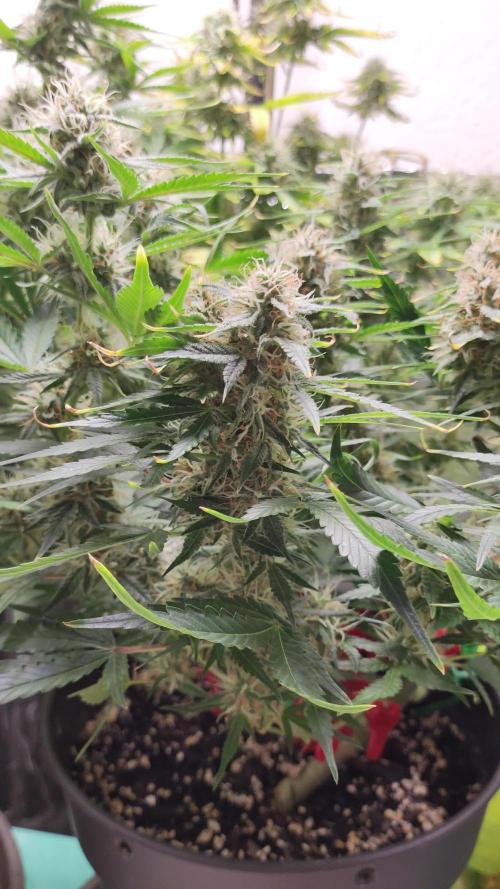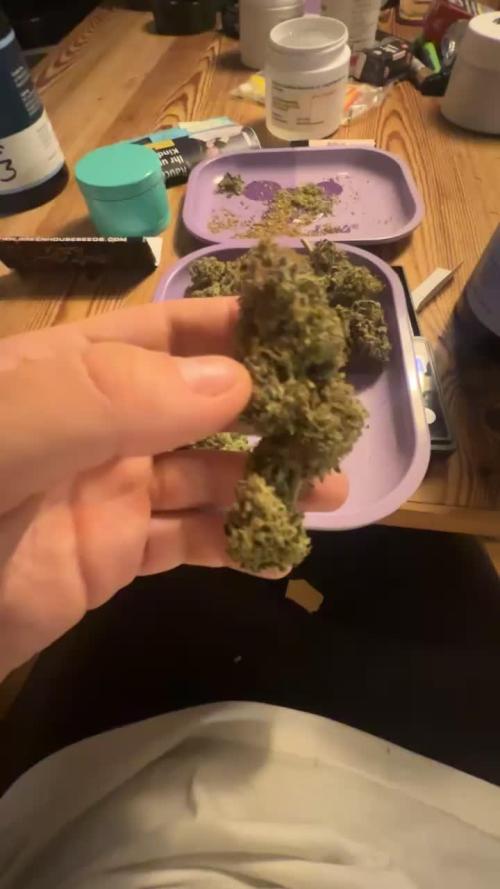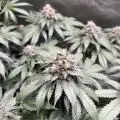The Grow Awards 2026 🏆 





























Likes
3
Share


@yungdanktwanog
Follow
Looking great I think pheno one will end up finishing a week early, maybe soon I will start the flush for pheno 1, as far as pheno 1 and 2 I will keep them going until I see more development
Likes
28
Share


@m0use
Follow
SPONSORED DIARY===SPONSORED DIARY===SPONSORED DIARY
Seeds finally popped up and out of the medium, giving them 24hr lighting till week 3 then will reduce it down to 18/6. Added in a few pics this week of the tent and light. nothing much else to report.
SPONSORED DIARY===SPONSORED DIARY===SPONSORED DIARY
Big shout out to @SpiderFarmer for supplying the 2x2x5 Grow tent and The SF1000 100w LED light.
I will be uploading all relevant photos of the products in the next week when they arrive, maybe do a little unboxing video. Who knows.
A 2nd big shout out to Dr.Seeds for supplying the 3x5pac of seeds I will only be featuring two of the three strains in two separate diaries.
You the users will get to decide what ones I grow. I have setup a Grow Question on each diary to vote for your strain of choice for that diary.
https://growdiaries.com/grow-questions/47600-drseeds-1-vote-what-i-grow "Diary #1"
https://growdiaries.com/grow-questions/47600-drseeds-1-vote-what-i-grow "Diary #2"
Cast your vote for each diary.
Thought I would add in the relevant links if you wanted to read up on any of the products that will be officially featured in this grow.
https://www.spider-farmer.com/
https://growdiaries.com/grow-lights/spider-farmer (+) https://www.spider-farmer.com/products/sf-1000-led-grow-light/
https://growdiaries.com/grow-tents/spider-farmer (+) https://www.spider-farmer.com/products/sf-2-x2-indoor-grow-tent-hydroponic-home-plant-reflective-aluminum-oxford-cloth/
https://drseeds.net/
https://growdiaries.com/seedbank/dr-seeds
(+)
https://drseeds.net/product/cherry-pie-autoflowering-cannabis-seeds/ (+) [No relevant GD affiliated link]
https://drseeds.net/product/granddaddy-purple-autoflowering-cannabis-seeds/ (+) https://growdiaries.com/seedbank/dr-seeds/granddaddy-purple [Photoperiod not Autoflowering]
https://drseeds.net/product/60-day-wonder-autoflowering-cannabis-seeds/ (+) https://growdiaries.com/seedbank/dr-seeds/60-day-wonder-autoflowering
Likes
33
Share


@zera1337
Follow
Week 4:
I somehow managed to overwater 2 of my cuties. Having a humidifier + the fan not being properly positionend kinda lead to this. However, they are now looking stronger again and back on track.
Likes
2
Share


@Muuuy
Follow
Already in week 7 of our little experiment!
They are all growing slower while prioritizing on thickening their buds. #3 is still and will for ever be a problem, though! But we have definitly learned a lot from our fine ladies so far.
The smell is getting better every week, mostly consisting of a sour-apple-ring-aroma, which is actually kinda delicious!
Adjusted nutrient intake by increasing the amount of Bio-Grow because #2 showed signs of deficiency by her leaves slowly turning pale.
Watering every two days due to them living in that small 4,4L pot and probably having an dense root system by now.
This is plant #1/3.
She has developed the biggest buds so far, even merging some into one huge bud on a few branches.
Likes
7
Share


@BioBlaze
Follow
The 4-week-old plant in the rapid growth phase is a fascinating organism to behold. It's incredible to witness the transformation of a tiny seed into a thriving plant with a sturdy stem, extensive root system, and vibrant green leaves. As the plant enters the rapid growth phase, it seems to come to life, eagerly soaking up sunlight and nutrients to fuel its growth, stretching its leaves towards the sun in the morning. The excitement of watching your plants reach this stage is hard to describe. It's a reminder of the beauty and wonder of nature and the incredible potential of life.
She is receiving 4 ml/l general purpose organic flower fertilizer based on guano.
Likes
2
Share


@Growstopher
Follow
47.25
What’s up growers!
Just finished up germination and seedling stage on to veg! 1st week of veg plant is at 3rd internode so time to tie down method. Looking good so far. Only using 1/2 strength of nutes until more is needed.
Likes
2
Share


@Pinky_andthe_Brain
Follow
Today I’ve taken off the top buds. They were looking ready under a microscope. Hopefully the rest of the buds are ready in a couple of days.
Likes
9
Share


@rhodes68
Follow
9/17 Add new Supplement for the soil made from the obvious, tilapia farm.
Fish Sh!t - Zona is the test case for it, looking for as much culture as we may affordably get.
https://fishheadfarms.com/ for particulars Looks good so far just seeing how it goes before using it elsewhere. Liquid used as any nuet
Fed today :
Fish Sh!t - 3ml / Bio-Bloom - 18ml / Bio-Grow - 5ml / Final Top dressing of Happy Frog Phosphorus booster 2 tbs scratched in 1 inch / 1 Gal water
9/20 A little sun today enough to dry the buds well enough. Clearing out a tent tomorrow and getting her some light during the bad weather. Still think a week or so off, lot of plants harvesting this month.
9/22 Due to the best we can hope for is 20% sun today she is moved under the lights in the big tent. Can stay there about a week and hope this mess clears by then.
Likes
31
Share


@Dunk_Junk
Follow
She grew 13cm this week. Not bad. She's looking good. Tent is a little bit too overcrowded for her at the moment but in a few days the situation will be better.
Likes
3
Share


@Takeaims
Follow
A selection of a few plants but you can tell the f1 hybrids are just amazing for growth got loads of bud site hopeing for fat buds now still a few weeks to
Likes
3
Share


@arzaq
Follow
We made some adjustments to the LST.
We try to stop Thrips from spreading, using Neem oil with water spray. Continue with the fertilizer as the last week.
Likes
108
Share


@Targona
Follow
Hello GrowDiaries friends.
72 days since my little girl sprouted from seed/harvest time🌱
Sweet Seeds breeder technical and general parameters:
Red Pure Auto CBD 💚❤️💚❤️
Growing Red Pure Auto CB according to breeder:
This “pure CBD” autoflowering strain is notable for its red flowers, very low THC levels (0.4–0.5%) and high CBD content (15–17%). It is a cross between two of our own strains: Sweet Pure CBD (SWS65) and Red Poison Auto (SWS39).
It looks like most other indica plants with a large central bud, short side branches, a strong stem and plenty of resin.
The strain offers a sweet, earthy aroma and taste, with shades of fresh pine or cypress and hints of fruits of the forest.
It has a relaxing effect that washes away anxiety, which makes it ideal for medicinal users who do not want to feel any psychotropic effects from the THC 🌱🌿🌾
My experience:
Throughout the growing period, the plant was very vital, it had a beautiful healthy color, strong stems. The color is beautiful, a loud purple color that extends to half of the leaves. Unfortunately, in the second week of flowering, it stopped and stopped getting stronger in the buds. They were beautifully colored, but they stopped getting thicker. Apparently, this will be my fertilizer testing and each strain and seed reacted completely differently. In the end, it had a very small harvest. I remember it like that maybe from my early days of growing. I'm very sorry about this strain, because I'm going to make a tincture from pure CBD. Fortunately, I grew two of these plants and only kept a diary for one. 💩💩 💚🌱 👍🌞
Data sheet of the strain Red Pure Auto CBD 💚❤️💚❤️
Indica: 58.4%
Sativa: 40%
Ruderalis: 1.6%
THC: 0.4-0.5%
CBD: 15-17%
Ratio THC:CBD: (1:34-1:37)
Indoor Yield: 450-500 g/m²
Outdoor Yield: 30-100 g/plant
Indoor/Outdoor Harvest: 9 weeks from germination
Height: 50-90 cm
Purple Flower: approximately 95% of the specimens
Effects: Relaxing, Medicinal
Taste: Cypress, Earthy, Pine tree, Cool, Fruits of the Forest, Sweet
For growing I used:
---------------------------------------
Growing tent Mammoth PRO+ 80: 80x80x180cm
1x circulation fan: 15W 🌬️
LED lighting: Mars Hydro TS 1000 - 150W - vegetation and flowering 💡💡
Exhaust: duct fan - RAMTT100 🌬️
Odor filter: PRO-ECO HF carbon filter 160-240m3/h - 100mm - maximum air flow up to 240m3/h
4x Airpots 11 l
I mix the substrate:
Biobizz Lightmix + Perlite + Coco coir
For sale here 👇👇👇👇👇👇👇👇:
⚡⚡⚡⚡⚡⚡https://sweetseeds.com/cs/semena-the-red-family/3063-red-pure-auto-cbd.html ⚡⚡⚡⚡⚡
Thanks for the likes :)
See you soon 😍😍
Likes
7
Share


@DenDv1d
Follow
I’m going to start flushing this gorilla, almost all trichomes are milky and I want enough flush before they start leaning towards amber. Buds will probably ripen a bit more this last week as well. It's nice and crisp springweather, perfect to add some more frosting to those budstickles.
Likes
20
Share


@pifflestikkz
Follow
Day 73
Day 38 Flower
Monday 6th
Camera is doing no justice, little video, although to my own fault I did not have phone with me when feeding yesterday for decent pictures. I will update again on water tomorrow ✌️
So far stretch has stopped, the recovery from lollipopping and defoliating is immaculate, she is so strong, already seeing denser bud sites and focused energy towards tops.
Day 74 - picture updates, looking great 😍💪💚
Likes
6
Share


@La_VecinaCannabica83
Follow
Han crecido bastante,hoy las voy a regar y aplicaré BioGrow y BioEnhancer de Greenhouse Feeding en el sustrato.

























